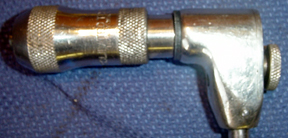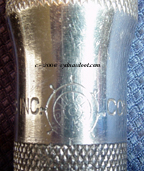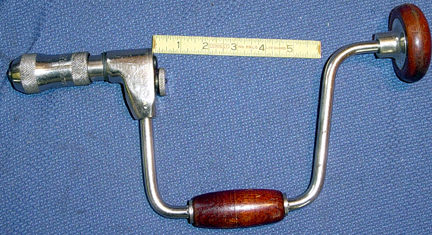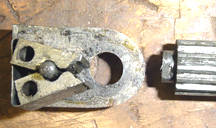Consolidated Tool Works.
The Consolidated Tool Works is recorded as having done business
in New York City from 1890 into the 1920s. Their mark featured a ships'
helm wheel, and is quite distinctive. They also used the brand name,
"Simplex." Consolidated sold a number of tools including

 machinist's
tools, drills, iron planes and braces. The braces are recognizable at a
glance, for they feature a ratchet selector in the form of a knurled knob on top
of the ratchet housing. The knob has a distinctive semilunate cutout that
provides access to the underlying screw that holds the ratchet gear in place.
Superficially the form of the ratchet and selector resembles the selector found
on the braces produced by the Davis Level & Tool Co. that are derived from
the patents of May 25, 1886 (#342727, Pearson "B") issued to John Bolen, and April 5,
1887 (#360650, Pearson "B") to Lawrence Bolen). However, the
internal mechanism on the Consolidated braces is vastly different from either of
these patented mechanisms.
machinist's
tools, drills, iron planes and braces. The braces are recognizable at a
glance, for they feature a ratchet selector in the form of a knurled knob on top
of the ratchet housing. The knob has a distinctive semilunate cutout that
provides access to the underlying screw that holds the ratchet gear in place.
Superficially the form of the ratchet and selector resembles the selector found
on the braces produced by the Davis Level & Tool Co. that are derived from
the patents of May 25, 1886 (#342727, Pearson "B") issued to John Bolen, and April 5,
1887 (#360650, Pearson "B") to Lawrence Bolen). However, the
internal mechanism on the Consolidated braces is vastly different from either of
these patented mechanisms.

These braces are sturdy, well-made ones and they are not
uncommon. However, I've never found one marked with a patent for the
ratchet mechanism. This mechanism is a unique one
 in my experience,
for the pawls are enclosed within a flat spring shaped in a triangular form.
The shaft of the selector knob passes between the pawls, and a bend in the shaft
pushes one pawl or the other as the knob is turned, effectively disengaging one
or the other pawl. This mechanism is contained within a space that is
accessed by removing a flat steel top to the compartment.
in my experience,
for the pawls are enclosed within a flat spring shaped in a triangular form.
The shaft of the selector knob passes between the pawls, and a bend in the shaft
pushes one pawl or the other as the knob is turned, effectively disengaging one
or the other pawl. This mechanism is contained within a space that is
accessed by removing a flat steel top to the compartment.
After reviewing all of the ratchet patents available to me,
only one comes close (really, very close) to this arrangement. It is No.
875,493, issued to Michael A. Beard of Cabool, Arkansas on
Dec. 31, 1907 (Pearson, "NS"). Mr. Beard's patent description emphasizes a
"quick-acting brace-chuck" as the main portion of his patent. The ratchet
mechanism is clearly figured, but only occupies about 11 lines of text (out of
140 lines) it is description. Yet the mechanism is surely identical to the
one found in the Consolidated braces.
Return to Brace INDEX

 machinist's
tools, drills, iron planes and braces. The braces are recognizable at a
glance, for they feature a ratchet selector in the form of a knurled knob on top
of the ratchet housing. The knob has a distinctive semilunate cutout that
provides access to the underlying screw that holds the ratchet gear in place.
Superficially the form of the ratchet and selector resembles the selector found
on the braces produced by the Davis Level & Tool Co. that are derived from
the patents of May 25, 1886 (#342727, Pearson "B") issued to John Bolen, and April 5,
1887 (#360650, Pearson "B") to Lawrence Bolen). However, the
internal mechanism on the Consolidated braces is vastly different from either of
these patented mechanisms.
machinist's
tools, drills, iron planes and braces. The braces are recognizable at a
glance, for they feature a ratchet selector in the form of a knurled knob on top
of the ratchet housing. The knob has a distinctive semilunate cutout that
provides access to the underlying screw that holds the ratchet gear in place.
Superficially the form of the ratchet and selector resembles the selector found
on the braces produced by the Davis Level & Tool Co. that are derived from
the patents of May 25, 1886 (#342727, Pearson "B") issued to John Bolen, and April 5,
1887 (#360650, Pearson "B") to Lawrence Bolen). However, the
internal mechanism on the Consolidated braces is vastly different from either of
these patented mechanisms.
 in my experience,
for the pawls are enclosed within a flat spring shaped in a triangular form.
The shaft of the selector knob passes between the pawls, and a bend in the shaft
pushes one pawl or the other as the knob is turned, effectively disengaging one
or the other pawl. This mechanism is contained within a space that is
accessed by removing a flat steel top to the compartment.
in my experience,
for the pawls are enclosed within a flat spring shaped in a triangular form.
The shaft of the selector knob passes between the pawls, and a bend in the shaft
pushes one pawl or the other as the knob is turned, effectively disengaging one
or the other pawl. This mechanism is contained within a space that is
accessed by removing a flat steel top to the compartment.